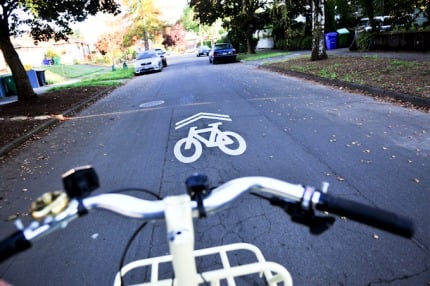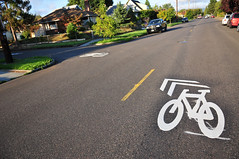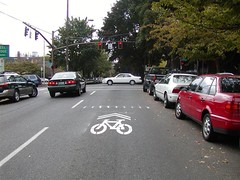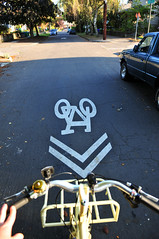
(Photos © J. Maus)
This week’s question comes from reader Shetha Nolke from Southeast Portland.
“I was recently pedaling down a road that is marked with the big new sharrows (SE Salmon), when I was approached by a motorist. She had been behind me, honking. When oncoming traffic cleared, she pulled beside me and said “I know you are allowed to ride in the road, but you really need to move to the right.”
I’m usually a very congenial rider and share the road nicely, but in this case, I would have been moving into the door zone if I listened to her. So I just shook my head “no” and continued on my course. She then zoomed off to the next stop sign. I didn’t want to tick her off, but I was to the right of the sharrow markings, and just to the left of the door zone.
Do bicyclists rights on these neighborhood greenways change from any other vehicular rights? I know that the law requires us to move over if we are going slower than the speed of traffic, but is that still the rule on these sharrow-marked streets?
I had heard that sharrows are used to mark where a cyclist was to place themselves in the lane, but I can’t quite bring myself to go that far over, in some cases. Does it really signify where to ride or just that the road is “shared”?
Great questions Shetha. The answer to your first one is no, your legal status as a bicycle operator does not change when you are on a bike boulevard (a.k.a. neighborhood greenway).
And yes, the law (ORS 814.430) about riding “as far to the right as practicable” and not impeding the “normal and reasonable movement of traffic” still applies on streets with sharrow markings.
All that being said, it’s understandable that you are confused. In their intended form, sharrows are meant to show bicycle operators where to position themselves on the roadway. They are usually used on streets with high motor-vehicle and bicycle traffic volumes where there’s not enough room to fit a bike lane (NW 19th, in the photo above, is a textbook example).

demonstrate, PBOT is using them as
bike boulevard and wayfinding markings
in addition to warn folks that the road
is shared by bikes and cars.
However, the 2,000-plus sharrows on bike boulevards in Portland are being used in an unconventional way. Instead of being used solely to show a shared lane and to demonstrate proper lane positioning, PBOT is also using them as bike boulevard (wayfinding) markings. Portland’s sharrows are also placed much further to the center of the lane than I’ve seen in any other city.
There’s at least one vocal bike activist in town who feels it’s a big mistake to use sharrows as bike boulevard markings because the national guidelines do not specifically mention that as one of their uses and doing so could dilute their meaning and cause confusion.
The reason PBOT used sharrows on bike boulevards instead of bike boulevard-specific pavement markings comes down to funding. The Federal Stimulus grant that funded the project would only pay for a marking type that had been formally adopted into the national standards. Sharrows fit the bill so they got the nod.
So, to recap: In Portland, sharrows have multiple and overlapping meanings. On some streets (like NW 19th) they tell you where to position yourself in the lane, but on other streets (like SE Salmon) they are simply wayfinding markings to help communicate that you are on a bike boulevard. But in all cases, sharrows mean that people in cars should expect bikes and vice versa.
I hope that answers your questions. If not, I’m happy to offer clarifications in the comments. Sharrows have become a huge part of our traffic landscape here in Portland, so we really need to be clear about what they mean and how to use them.
— Got a bike question? Ask us. Browse past questions and answers at our Ask BikePortland archives.




